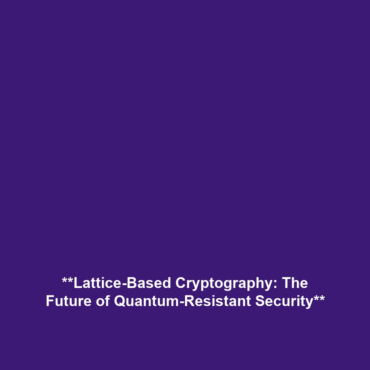The National Institute of Standards and Technology (NIST) and Post-Quantum Cryptography
Introduction
The National Institute of Standards and Technology (NIST) is at the forefront of modern cryptography, currently focusing on the urgent task of standardizing post-quantum cryptographic algorithms. As digital technology continues to evolve, the threat posed by quantum computing to traditional cryptographic systems becomes increasingly apparent. This article examines the significance of NIST’s efforts in ensuring future security within the field of cryptography, discussing its crucial role in developing robust solutions that can withstand quantum attacks.
Key Concepts
Understanding Post-Quantum Cryptography
Post-quantum cryptography refers to cryptographic methods that are secure against the potential threats posed by quantum computers. With their ability to solve complex problems exponentially faster than classical computers, quantum systems pose a risk to commonly used cryptographic algorithms such as RSA and ECC.
Roles of NIST in Cryptography
NIST’s initiative encompasses a rigorous process of evaluating and standardizing various post-quantum algorithms to provide consistency and security in cryptographic practices. This includes extensive security analysis, community feedback, and final selections of candidate algorithms aimed at forming new standards for both federal and commercial systems.
Applications and Real-World Uses
The applications of NIST’s standardized post-quantum cryptographic algorithms extend across various sectors, particularly where data security is paramount. These include:
- Financial Services: Ensuring secure transactions and protecting sensitive financial data from quantum threats.
- Healthcare: Safeguarding patient records and complying with regulations like HIPAA through secure encryption techniques.
- Government Communications: Protecting national security information transmitted over potentially susceptible quantum channels.
Understanding how post-quantum cryptography is used in these critical applications can enhance overall security standards across industries.
Current Challenges
Despite the progress, there are significant challenges that NIST faces in the standardization of post-quantum cryptographic algorithms:
- Algorithm Selection: Evaluating and ensuring that the selected algorithms remain secure against both current and future quantum threats.
- Performance Issues: Balancing security with the need for algorithms to perform efficiently on various platforms.
- Integration: Ensuring compatibility with existing systems while transitioning to new quantum-resistant algorithms.
Future Research and Innovations
As the landscape of cryptography evolves, ongoing research into next-generation technologies is essential. Current innovations in the post-quantum domain include:
- Development of hybrid encryption systems that combine classical and post-quantum algorithms.
- Advancements in lattice-based cryptography, which is considered a strong candidate for post-quantum standards.
- Collaborative efforts among international bodies to create globally accepted standards for cryptographic algorithms.
Conclusion
The standardization of post-quantum cryptographic algorithms by the National Institute of Standards and Technology (NIST) is a significant step towards securing digital communications against the imminent risks posed by quantum computing. As the research and development in this area continue, the importance of proactive measures cannot be overstated. For further information on cryptographic standards and practices, consider exploring additional articles on NIST’s cryptographic standards and their implications for future security.

